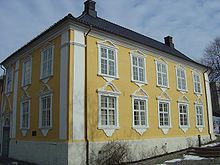- Convention of Moss
-
Convention of Moss (Mossekonvensjonen) Type armistice agreement de facto peace treaty Signed August 14, 1814 Location Moss, Norway Effective Immediately Expiration Three weeks following the first parliamentary session, effectively indefinitely Signatories Sweden, provisional government of Norway Language French The Convention of Moss was a cease fire agreement, signed August 14, 1814, between the Swedish King and the Norwegian Storting. It followed the Swedish-Norwegian War due to Norway's claim to sovereignty. It also became the de facto peace agreement and formed the basis for the personal union between Sweden and Norway that lasted until Norway declared the dissolution of the union in 1905.
In 1814, Denmark–Norway was on the losing side in the Napoleonic wars. On January 14, 1814, at the Treaty of Kiel, Norway was ceded to the king of Sweden. In an attempt to take control of their destiny the Norwegians convened a constitutional assembly at Eidsvoll and on May 17, 1814 signed the Constitution of Norway. The vice-roy and heir to the thrones of Denmark and Norway, prince Christian Frederik, was elected by the assembly as king.
The Swedish king, Karl XIII rejected the premise of an independent Norway and launched a military campaign on July 27, 1814 with an attack on the Hvaler islands and the city of Fredrikstad. The Swedish army was superior in numbers, was better equipped and trained, and was led by one of Napoleon's foremost generals, the newly elected Swedish crown prince, Charles John.
The hostilities opened on 26 July with a swift Swedish naval attack against the Norwegian gunboats at Hvaler. The Norwegian vessels managed to escape, but they did not take part in the rest of the war. The main Swedish thrust came across the border at Halden, bypassing and surrounding the fortress of Fredriksten, and then continuing north, while a second force of 6,000 soldiers landed at Kråkerøy outside of Fredrikstad. This town surrendered the next day. This was the start of a pincer movement around the main part of the Norwegian army at Rakkestad. The Norwegian army delivered several offensive blows to the Swedes, thus applying pressure on the Swedes to accept Norway as a sovereign nation, and opening up negotiations. Armistice negotiations concluded at Moss on August 14, 1814.
In the peace negotiations, Christian Frederik agreed to relinquish claims to the Norwegian crown and return to Denmark if Sweden would accept the democratic Norwegian constitution and a loose personal union. The convention comprised four documents, all written in French, with the following main points:
- The agreement was entered into between the Swedish crown prince on behalf of the Swedish King, and the Norwegian parliament. The Swedes did not recognize Christian Frederik's claim to the Norwegian throne, so he was not a party to the official agreement. (Though a secret agreement was also executed ordering him to return to Denmark).
- The Norwegian parliament was to convene by the end of September, or the beginning of October, to ratify the convention.
- The King of Sweden accepted the Norwegian constitution, with only such amendments as were necessary to accommodate the union with Sweden. All changes were to be accepted by the Norwegian parliament.
- Christian Frederik should abandon all claims to the Norwegian crown and leave Norway.
Norwegians were shocked by their government's concessions, and when the Swedish general Magnus Björnstjerna, who had led the Swedish negotiations, arrived in Christiania, Norway, he got an unfriendly welcome. Norwegians also directed their resentment toward their own leaders and what they perceived as spineless military defense. Over time, public opinion shifted. The convention was a significant improvement over the terms dictated to Denmark–Norway at the treaty of Kiel. Notably, Norway was no longer to be treated as a Swedish conquest but rather as an equal party in a union of two independent states. Both the principle and substance of the Norwegian Constitution were accepted, and Norway retained its own parliament and separate institutions, except for the common king and foreign service. This was the last war between Sweden and Norway, and Sweden's last war.
See also
- Union between Sweden and Norway
- Treaty of Kiel
- Norway in 1814
- Swedish-Norwegian War (1814)
- Constitution of Norway
Coordinates: 59°26′22″N 10°40′10″E / 59.43944°N 10.66944°E
Categories:- 1814 in Norway
- Norwegian monarchy
- Scandinavian history
- Swedish monarchy
- Peace treaties of Sweden
- Military history of Norway
- 1814 treaties
Wikimedia Foundation. 2010.

